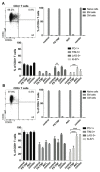Antibody-based Delivery of TNF to the Tumor Neovasculature Potentiates the Therapeutic Activity of a Peptide Anticancer Vaccine
- PMID: 30327303
- PMCID: PMC6978140
- DOI: 10.1158/1078-0432.CCR-18-1728
Antibody-based Delivery of TNF to the Tumor Neovasculature Potentiates the Therapeutic Activity of a Peptide Anticancer Vaccine
Abstract
Purpose: There is a growing interest in the use of tumor antigens for therapeutic vaccination strategies. Unfortunately, in most cases, the use of peptide vaccines in patients does not mediate shrinkage of solid tumor masses.Experimental Design: Here, we studied the opportunity to boost peptide vaccination with F8-TNF, an antibody fusion protein that selectively delivers TNF to the tumor extracellular matrix. AH1, a model antigen to investigate CD8+ T-cell immunity in BALB/c mice, was used as vaccine.
Results: Peptide antigens alone exhibited only a modest tumor growth inhibition. However, anticancer activity could be substantially increased by combination with F8-TNF. Analysis of T cells in tumors and in draining lymph nodes revealed a dramatic expansion of AH1-specific CD8+ T cells, which were strongly positive for PD-1, LAG-3, and TIM-3. The synergistic anticancer activity, observed in the combined use of peptide vaccination and F8-TNF, was largely due to the ability of the fusion protein to induce a rapid hemorrhagic necrosis in the tumor mass, thus leaving few residual tumor cells. While the cell surface phenotype of tumor-infiltrating CD8+ T cells did not substantially change upon treatment, the proportion of AH1-specific T cells was strongly increased in the combination therapy group, reaching more than 50% of the CD8+ T cells within the tumor mass.
Conclusions: Because both peptide vaccination strategies and tumor-homing TNF fusion proteins are currently being studied in clinical trials, our study provides a rationale for the combination of these 2 regimens for the treatment of patients with cancer.
©2018 American Association for Cancer Research.
Conflict of interest statement
Figures







References
-
- Melero I, Gaudernack G, Gerritsen W, Huber C, Parmiani G, Scholl S, et al. Therapeutic vaccines for cancer: an overview of clinical trials. Nature Reviews Clinical Oncology. 2014;11:509. - PubMed
Publication types
MeSH terms
Substances
LinkOut - more resources
Full Text Sources
Research Materials
Miscellaneous

